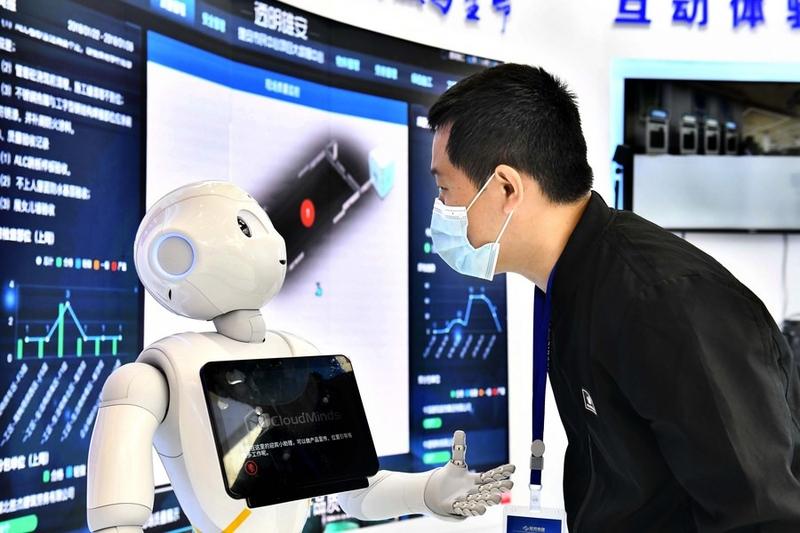 This photo taken on May 26, 2023 shows a full-size humanoid bionic robot displayed at the exhibition center of Zhongguancun National Independent Innovation Demonstration Zone in Beijing, capital of China. (PHOTO / XINHUA)
This photo taken on May 26, 2023 shows a full-size humanoid bionic robot displayed at the exhibition center of Zhongguancun National Independent Innovation Demonstration Zone in Beijing, capital of China. (PHOTO / XINHUA)
BEIJING - Large models based on algorithms, computing power and big data have become the mainstream of AI development, and have continuously empowered China's economic development.
As of October 2023, 238 big models have been launched in China, according to official data. Meanwhile, an increasing number of universities, institutes and innovative enterprises are jumping on the bandwagon of AI large models.
Large language models have garnered significant attention in recent years, with a proliferation of products attracting a substantial user base based on their functionalities such as language understanding, logical reasoning, knowledge question and answer, and text generation.
 Visitors gather at the booth of iFlytek during the Smart China Expo in Chongqing on Aug 27, 2023. (PHOTO PROVIDED TO CHINA DAILY)
Visitors gather at the booth of iFlytek during the Smart China Expo in Chongqing on Aug 27, 2023. (PHOTO PROVIDED TO CHINA DAILY)
China's leading AI company iFLYTEK unveiled its AI-powered large language model dubbed "Spark Desk" last year. The number of its users had exceeded one million just within 14 hours after it was launched.
The multitask model covers key features including AI-generated content, multi-language understanding, logical reasoning, mathematics and coding.
China's tech giant Baidu rolled out its large language model and ChatGPT-like product dubbed Ernie Bot in March, 2023. It can provide a wide range of services, such as welcome speeches, speech drafts, business plans, instructions, flow charts and mind maps, covering many aspects of work and life.
ALSO READ: AI model helps diagnose ovarian cancer
 A staff member (1st first) introduces an AI character recognition system to visitors at the 2022 World Artificial Intelligence Conference in east China's Shanghai, Sept 1, 2022. (PHOTO / XINHUA)
A staff member (1st first) introduces an AI character recognition system to visitors at the 2022 World Artificial Intelligence Conference in east China's Shanghai, Sept 1, 2022. (PHOTO / XINHUA)
As of December 28, 2023, the user base of Ernie Bot had exceeded 100 million, making it China's first large model product to provide paid services for consumers.
The research and development of large models represent a key focus of future scientific endeavors, albeit with high entry barriers and related challenges. Only by fully integrating into various industries, can the large models serve the real economy more effectively and achieve sustainable development.
In recent years, China's self-developed AI-driven large models have showcased great application potential in the real economy, such as smart mining, drug R&D, meteorology, government affairs, finance, intelligent manufacturing and railway management.
In the manufacturing sector, robots equipped with large models help workers improve their efficiency. In the transportation field, traffic management departments can use large models to optimize traffic flow and road conditions.
ALSO READ: AI will continue to make waves in 2024
 An attendee interacts with a robot during the 1st Summit of Jinan National Artificial Intelligence Innovation and Application Pilot Zone & the Exposition of Artificial Intelligence Innovation and Application on Yellow River Basin in Jinan, east China's Shandong province, April 19, 2021. (PHOTO / AP)
An attendee interacts with a robot during the 1st Summit of Jinan National Artificial Intelligence Innovation and Application Pilot Zone & the Exposition of Artificial Intelligence Innovation and Application on Yellow River Basin in Jinan, east China's Shandong province, April 19, 2021. (PHOTO / AP)
In the realm of drug R&D, large models can expedite the process of new drug research and development, and achieve highly efficient, innovative, and personalized drug design and discovery by using natural language processing, knowledge graphs, and molecular modeling.
As a deep learning model with hundreds of billions of scale parameters and complex structures, a large model has extremely high requirements for the carrying capacity and efficiency of computing power.
Many cities with strong demands for AI are increasing the supply of computing power, such as Beijing, Shenzhen and Shanghai, also dubbed as the "first echelon" of China's AI development. These cities have successively issued relevant policies to support the layout of computing power infrastructure.
According to a white paper on China's computing power development index, the intelligent computing power developed rapidly to account for 59 percent of the nation's computing power in 2023.


